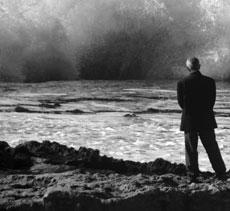Hurricane season is officially starting. Florida gets a tax-free week just to stock up on supplies to prevent their cities from turning to mush. So how should we deal with this constant weather crisis, one that is getting worst as the years progress, and global warming increases? For once the answer may not be political. The obvious solution is to stop the hurricanes. Moshe Alamaro, of MIT, has figured out how, amazingly, without a blustery cape or light beams shooting from his fingertips.
His technology was presented at the weather modification conference last April. In actuality it is quite simple and dissipates hurricanes by one of the ways in which we stop forest fires – directing forces of nature consists in our restriction of their fuel. In the case of conflagrations we start small, low-intensity fires by using a device such as the driptorch, or pyrotechnic flares, to burn the flammable material in a controlled way. Thus both fires go head to head until they both run out of flammable material and are then extinguished. Using this knowledge Dr. Alamaro proposes to not only stop a hurricane but to actually do this by starting one. His scheme consists of an off-shore barge, containing ten to twenty jet engines, that starts an updraft. The water evaporates from the surface and cools down the surface of the ocean. Since wind speed exponentially correlates to the temperature of the water, a small decrease in temperature leads to a large decrease in hurricane. The result, theoretically, is a harmless tropical storm.
In a world lacking non-profit superheroes, the big question is the cost of the technology. Dr. Alamaro suggests that the jet engines can be picked up from military graveyards hosting American and Soviet long-range bombers. The total cost for a single barge would be $1 billion, at maximum. A different barge would be needed for different regions of the ocean, or they would have to be made portable. Considering the $200 billion dollar price tag of Katrina, $25 billion for Andrew, and the cost of rebuilding Florida every year, the technology is most definitely value priced.
Alas, politics manages to stick its ugly head in and prevents Dr. Alamaro from reaching the super-hero status he deserves. If Dr. Alamaro’s technology were to get sponsored one of three following scenarios could occur. First of all there is always the miniscule error percentage within all science (including your next surgery) that something does not work. In that case he gets sued. In the second scenario, the technology is successful, in which case the hurricane is dissipated and instead of destroying a whole town, there are only the repercussions of heavy rain. In that case he is sued for the possible resulting damage. In the final scenario, the hurricane can be dispelled as well, but can go in a different direction. So instead of destroying the town of Miami it hits two houses out on an island somewhere. You guessed it, he gets sued nonetheless.
There is no policy preventing Dr. Alamaro and sponsors, from taking responsibility for the hurricane once it is meddled with. Especially since the meddling process requires creating a miniature hurricane. Although he is reducing damage that would have occurred anyway, he gets fault for comparably minor damages. So maybe, the answer is always political. Until the day comes where politicians are willing to allow scientists the power to control the weather we all simply have to just deal with Mother Nature’s wrath.





















































